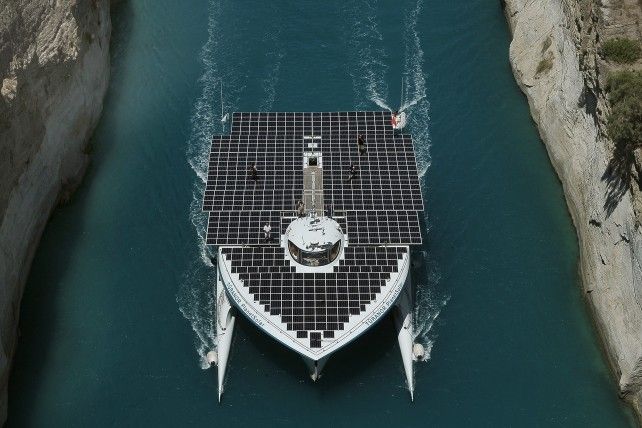All manner of analogies invoking explosions or meteors could be used to describe the trajectory of solar energy over the past decade. Yet it is unlikely that any of them would tell the story of its astonishing progress quite as vividly as the raw data itself.
According to figures published by the European Photovoltaic Industry Association (EPIA), the total solar photovoltaic (PV) capacity installed worldwide had grown to nearly 140 gigawatts (GW) last year from a little over 1GW in 2000 – more than 10,000 per cent in 13 years. Less stellar, but still significant, PV’s near relative, solar thermal energy (STE), hit over 3.4GW of installed capacity last year after seeing steady growth since its first installation in 1984.
“Both PV and STE are proven technologies,” says Maria van der Hoeven, executive director of the International Energy Agency (IEA). “The rapid cost decrease of PV modules and systems in the last few years has opened new perspectives for using solar energy as a major source of electricity in the coming years and decades.”
HARNESSING SUN’S HEAT
The difference between the two technologies is that PV uses semiconductor materials to convert sunlight directly into electricity, whereas STE, also known as concentrated solar power (CSP), harnesses the sun’s heat to drive turbines that generate power. The attraction of both is that their “fuel” is the sun’s virtually limitless energy, making them both promising alternatives to hydrocarbons.
PV’s growth in recent years has largely been due to the involvement of China. Not only does its huge, energy-hungry population make it an attractive end-market for solar – forecast to be the world’s largest this year – but its manufacturing ingenuity has also proved instrumental in driving down the costs of solar panels to the extent that PV is now able to compete on almost level terms with conventional power sources.
In one hour the sun provides the equivalent energy of the entire Earth’s consumption in one year
This dramatic fall in costs has opened PV up to a whole new world of possibility. One of its big attractions is that it lends itself to areas of the developing world poorly served by centralised grid infrastructure, offering the promise of electrifying areas that would probably have to wait years for a connection.
“PV is an ideal way to provide power to that large portion of the world that doesn’t have it,” says Chris Case, chief technology officer at Oxford PV, an Oxford University spin-off company developing cutting-edge photovoltaic technologies. “Even small PV power stations can provide access to things like mobile phone charging, refrigeration for vaccines and TV receivers.”
South Africa has so far led the way among emerging economies, launching a renewable energy drive in which both solar PV and CSP feature prominently. Other African nations are following, with Kenya, Ghana and Ethiopia among the notable players. Outside Africa, small developing island nations are also latching on to solar; in 2012, Tokelau in the Pacific became the world’s first island to be entirely powered by solar. With PV’s scope increasing, EPIA predicts it will reach as much as 430GW by 2018.
But the real excitement with solar is over what is yet to come. Oxford PV is involved in developing a new material that it claims promises leaps forward in both the efficiency and cost of harnessing the sun’s energy.
Mr Case says the company’s material, perovskite, has demonstrated the potential to significantly outperform the current silicon-based materials used in PV panels. Its big selling point is that can be incorporated directly into buildings, effectively turning them into power stations.
“It can do something that no other material can do: it can become part of the glazing on buildings,” he says. “Implemented in that way, a building like the Shard in London becomes a 2.8-megawatt (MW) vertical power station, generating over 1 gigawatt-hour of electricity a year. That is a completely new market.”
OTHER APPLICATIONS
Beyond buildings, PV technology is finding its way into a host of other new spheres. The first round-the-world flight powered by PV was completed last year by the futuristic Solar Impulse aircraft, while tech giant Apple has also recently taken out various patents that industry observers believe herald its move into solar-powered smartphones. More outlandish applications include clothing that incorporates solar-powered phone-charging fabrics, though this remains some way from becoming mainstream.
Despite some attempts by fossil fuel lobbyists to disrupt the advance of solar in countries such as the United States and Germany, the compelling fact about the technology is that in almost no time it has gone from being an expensive sideshow, in some eyes, to a potential game-changer. The IEA has just published a report positing solar as the world’s largest source of energy by 2050. As the technology improves and the economics become even harder to ignore, it would take a brave soul to bet against that happening.
“In one hour the sun provides the equivalent energy of the entire Earth’s consumption in one year,” says Mr Case. “Outside of wind, solar is the only renewable energy source that can potentially power the entire world.”
HARNESSING SUN’S HEAT

OTHER APPLICATIONS

